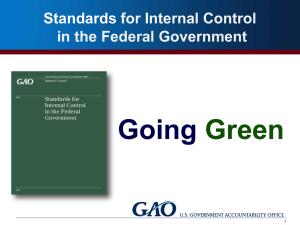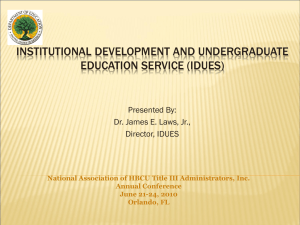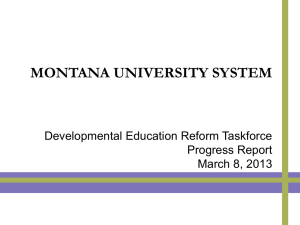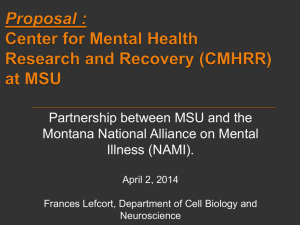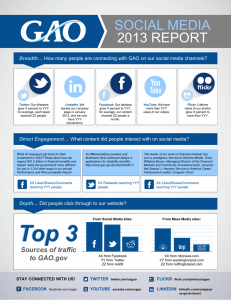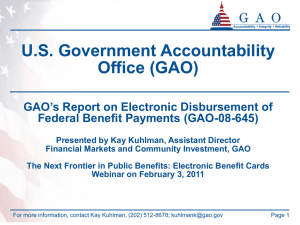Internal Control in Higher Education
advertisement
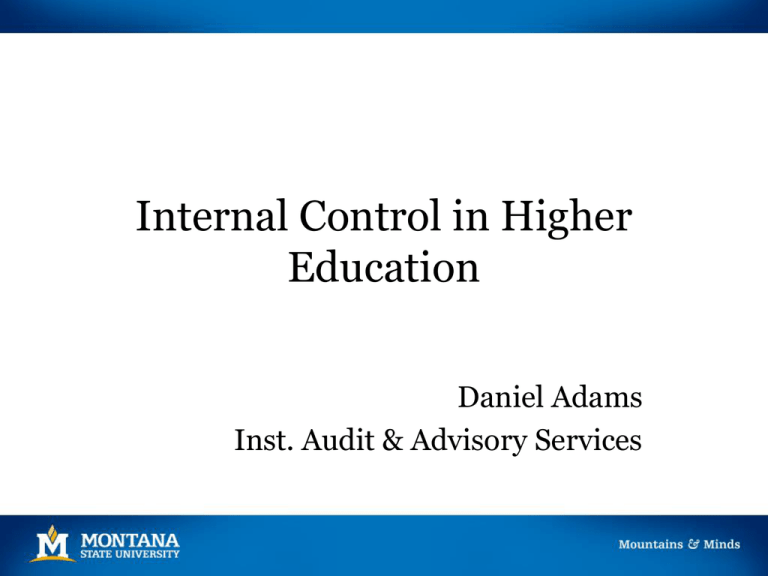
Internal Control in Higher Education Daniel Adams Inst. Audit & Advisory Services About IAAS • Evaluate (internal) control processes • Monitor: – Compliance with policies, procedures laws and regulations – Means of safeguarding assets – Effectiveness and efficiency – Risk management processes – Quality and continuous improvement in operations • Investigate suspected fiscal misconduct Source: http://www.montana.edu/audit/iaas_charter.html Internal Control in HE Overview • 5 elements and 17 principles of internal control • Areas where internal control processes should commonly be implemented in HE • Tools for assessing and improving internal control processes in your unit Office of Management and Budget (OMB) Circular A-81 §200.303 Internal controls. The non-Federal entity must: (a) Establish and maintain effective internal control over the Federal award that provides reasonable assurance that the non-Federal entity is managing the Federal award in compliance with Federal statutes, regulations, and the terms and conditions of the Federal award. OMB Circular A-81 §200.303 Internal controls. These internal controls should be in compliance with guidance in ‘‘Standards for Internal Control in the Federal Government’’ issued by the Comptroller General of the United States and the ‘‘Internal Control Integrated Framework’’, issued by the Committee of Sponsoring Organizations of the Treadway Commission (COSO). What is internal control? Internal Control Frameworks COSO Internal Control–Integrated Framework • COSO (Committee of Sponsoring Organizations) of the Treadway Commission – American Accounting Association (AAA) – American Institute of Certified Public Accountants (AICPA) – Financial Executives International (FEI) – Institute of Management Accountants (IMA) – The Institute of Internal Auditors (IIA) The Green Book • Standards for Internal Control in the Federal Government – Government Accountability Office (GAO) – Comptroller General of the United States – “May also be adopted by state, local, and quasi-governmental entities as a framework for an internal control system” Source: Standards for Internal Control in the Federal Government. GAO. September 2014. Other Internal Control Frameworks • Canadian Institute of Chartered Accountants Control Framework • Control Objectives for Information and Related Technology (COBIT) • International Organization for Standardization (ISO) Internal Control Definitions COSO Internal Control Definition Internal control is a process, effected by an entity’s board of directors, management, and other personnel, designed to provide reasonable assurance regarding the achievement of objectives relating to operations, reporting, and compliance. Source: COSO Internal Control – Integrated Framework. May 2013. Green Book Internal Control Definition Internal control is a process effected by an entity’s oversight body, management, and other personnel that provides reasonable assurance that the objectives of an entity will be achieved. Source: Standards for Internal Control in the Federal Government. GAO. September 2014. Green Book Internal Control Definition These objectives and related risks can be broadly classified into one or more of the following three categories: • Operations - Effectiveness and efficiency of operations • Reporting - Reliability of reporting for internal and external use • Compliance - Compliance with applicable laws and regulations Source: Standards for Internal Control in the Federal Government. GAO. September 2014. OMB Circular A-81 §200.303 Internal controls. (b) Comply with Federal statutes, regulations, and the terms and conditions of the Federal awards. Green Book Internal Control Definition Internal control comprises the plans, methods, policies, and procedures used to fulfill the mission, strategic plan, goals, and objectives of the entity. Source: Standards for Internal Control in the Federal Government. GAO. September 2014. Green Book Internal Control Definition Internal control serves as the first line of defense in safeguarding assets. Source: Standards for Internal Control in the Federal Government. GAO. September 2014. Green Book Internal Control Definition In short, internal control helps managers achieve desired results through effective stewardship of public resources. Source: Standards for Internal Control in the Federal Government. GAO. September 2014. International Organization for Standardization (ISO) Control Definition Administrative, managerial, technical or legal methods for managing risk, including policies, procedures, guidelines, practices or organizational structures Source: ISO 27000 Information security management systems. ISO Risk Definition Combination of the probability (likelihood) of an event and its consequence (impact) Source: ISO 27000 Information security management systems. Who is responsible for internal control at MSU? Green Book Internal Control Definition People are what make internal control work. Management is responsible for an effective internal control system. However, personnel throughout an entity play important roles in implementing and operating an effective internal control system. Source: Standards for Internal Control in the Federal Government. GAO. September 2014. Characteristics of Higher Education • Large organizations – Offices with functional (e.g., finance, HR) expertise • Decentralized • Partially taxpayer funded • Highly regulated • Some managers do not have prior business-type experience Five Components of Internal Control 17 Principles Support the Five Components Control Environment The oversight body and management establish and maintain an environment throughout the entity that sets a positive attitude toward internal control. Source: Standards for Internal Control in the Federal Government. GAO. September 2014. Control Environment - Principle 1 The oversight body and management demonstrate a commitment to integrity and ethical values. 1. Tone at the Top 2. Standards of Conduct 3. Adherence to Standards of Conduct Source: Standards for Internal Control in the Federal Government. GAO. September 2014. What do you think about MSU’s commitment to integrity and ethical values? MSU Compliance Hotline Montana State University’s four campuses are committed to acting with integrity in their pursuit of excellence. As part of this commitment, the university has selected a private contractor, EthicsPoint, to provide an independent avenue for confidential reporting of concerns about suspected legal, regulatory or policy violations. www.msucompliancehotline.ethicspoint.com Reporting Suspected Legal, Regulatory and Policy Violations Montana State University encourages all faculty, staff, students, and volunteers, acting in good faith, to report suspected legal, regulatory or policy violations. The university is committed to protecting individuals from retaliation for making a good faith report. http://www.montana.edu/policy/reporting-violations/ Fiscal Misconduct Policy Any employee or student associated with the University who knows of or suspects fiscal misconduct should promptly notify one of the following: the director of Institutional Audit & Advisory Services, Legal Counsel, or director of University Police. http://www.montana.edu/policy/fiscal_misconduct/a udit100.html Control Environment - Principle 2 The oversight body should oversee the entity’s internal control system. 1. Oversight Structure 2. Oversight for the Internal Control System 3. Input for Remediation of Deficiencies Source: Standards for Internal Control in the Federal Government. GAO. September 2014. How do MSU’s oversight bodies oversee the internal control system? http://www.mus.edu/borpol/default.asp How do they provide input for remediation of deficiencies? BOR Policy 930.1 – Internal Audit Reports An internal audit report for a campus of the Montana University System shall be provided to the Commissioner's Office when the report contains a conclusion that there has been or may have been a violation of institutional or system policy or of state or federal law. http://www.mus.edu/borpol/bor900/9301.htm Montana Code Annotated (MCA) 5-13-309. Information from state agencies. […] (3) The head of each state agency shall immediately notify both the attorney general and the legislative auditor in writing upon the discovery of any theft, actual or suspected, involving state money or property under that agency's control or for which the agency is responsible. http://leg.mt.gov/bills/mca/5/13/5-13-309.htm Control Environment - Principle 3 Management should establish an organizational structure, assign responsibility, and delegate authority to achieve the entity’s objectives. 1. Organizational Structure 2. Assignment of Responsibility and Delegation of Authority 3. Documentation of the Internal Control System Source: Standards for Internal Control in the Federal Government. GAO. September 2014. Do you think authority and responsibility are clearly assigned at MSU? Principal Investigator Guide • 710.00 Responsibilities of the PI in Post-Award Administration. • 720.00 Role of Departmental Business Managers/Accountants in Post-Award Administration. • 730.00 Role of OSP in Post-Award Administration. http://www.montana.edu/research/osp/piguide/700.00.html Do you have the authority to ensure that your unit is in compliance with policies, laws and regulations? Documentation of the Control System • Establishing and communicating who, what, when, where and why of internal control execution to personnel • Means to retain organizational knowledge that could be limited to a few personnel • Means to communicate effective control design to outside parties (e.g., auditors) Source: Standards for Internal Control in the Federal Government. GAO. September 2014. Guidance on Adequate Documentation Departmental Revenue Collection Procedures Model This document should be used by departments as a guide for the development or enhancement of their revenue collection procedures and should be tailored to each department’s specific situation. http://www.montana.edu/audit/guidance.html Control Environment - Principle 4 Management should demonstrate a commitment to recruit, develop, and retain competent individuals. 1. Expectations of Competence 2. Recruitment, Development, and Retention of Individuals 3. Succession and Contingency Plans and Preparation Source: Standards for Internal Control in the Federal Government. GAO. September 2014. How does MSU do at developing and training its people? How does MSU do at providing incentives to motivate and retain people? Control Environment - Principle 5 Management should evaluate performance and hold individuals accountable for their internal control responsibilities. 1. Enforcement of Accountability 2. Consideration of Excessive Pressures Source: Standards for Internal Control in the Federal Government. GAO. September 2014. Are people at MSU held accountable? Could people at MSU be feeling excessive pressures that could lead to corner cutting? Risk Assessment Management assesses the risks facing the entity as it seeks to achieve its objectives. This assessment provides the basis for developing appropriate risk responses. Source: Standards for Internal Control in the Federal Government. GAO. September 2014. 17 Principles Support the Five Components Risk Assessment - Principle 6 Management should define objectives clearly to enable the identification of risks and define risk tolerances. 1. Definitions of Objectives 2. Definitions of Risk Tolerances Source: Standards for Internal Control in the Federal Government. GAO. September 2014. Definitions of Objectives • For quantitative objectives, performance measures may be a targeted percentage or numerical value. • For qualitative objectives, management may need to design performance measures that indicate a level or degree of performance, such as milestones. Source: Standards for Internal Control in the Federal Government. GAO. September 2014. MSU Strategic Objectives Definitions of Risk Tolerances • Risk tolerance is the acceptable level of variation in performance relative to the achievement of objectives. – For financial reporting objectives, risk tolerance is typically expressed in terms of materiality. Source: Standards for Internal Control in the Federal Government. GAO. September 2014. Source: COSO Internal Control – Integrated Framework. May 2013. Definitions of Risk Tolerances • Compliance objectives - Concept of risk tolerance does not apply. An entity is either compliant or not compliant. Source: Standards for Internal Control in the Federal Government. GAO. September 2014. Risk Assessment - Principle 7 Management should identify, analyze, and respond to risks related to achieving the defined objectives. 1. Identification of Risks 2. Analysis of Risks 3. Response to Risks Source: Standards for Internal Control in the Federal Government. GAO. September 2014. Guidance on Risk Assessment Internal Control Assessments These questionnaires were designed to make it easy for staff members to determine if their units have implemented many of the control activities that are commonly needed at MSU and are based on MSU and State of Montana policies and procedures and sound administrative practices. http://www.montana.edu/audit/guidance.html Accounting & Budgeting Control Assessment (CA) • How do you ensure that all indexes are regularly monitored to know that you have adequate resources and prevent budget deficits? • Do you have plans for handling an unexpected deficit? • Do you use a subsidiary accounting system (e.g., CatBooks)? How is it used? Is it regularly reconciled to Banner (monthly)? • What reconciliations do you perform and at what frequency? What do you do if you detect errors or omissions? http://www.montana.edu/audit/guidance.html Human Resources CA • Recruitment and hiring are conducted in compliance with applicable requirements. • Regular, extra (e.g., overtime) and exception time (e.g., leave) is recorded, complete, reviewed and properly approved. • Payroll reports are reconciled periodically and discrepancies are properly resolved. http://www.montana.edu/audit/guidance.html Information Security CA • The unit has identified the types of information for which it is responsible. Sensitive information is not stored on hard drives of computers assigned to unit employees or students. • Information system access privileges for unit employees are periodically reviewed and accordingly changed or terminated. http://www.montana.edu/audit/guidance.html Information Security CA • Unit personnel do not download software from unknown sources or open attachments or links included in email without first thinking about the potential for resulting information security issues. • Software and operating system updates are applied immediately on unit information systems. http://www.montana.edu/audit/guidance.html OMB Circular A-81 §200.303 Internal controls. (e) Take reasonable measures to safeguard protected personally identifiable information and other information the Federal awarding agency or pass-through entity designates as sensitive or the non-Federal entity considers sensitive consistent with applicable Federal, state and local laws regarding privacy and obligations of confidentiality. Procurement & Disbursements CA • Purchases are not manipulated (e.g., two payments of $4,900 for a single item) to avoid following procurement procedures. • A written contract exists for all purchased services that amount to $500 or more. • Prior to entering into a contract, the unit determines whether the relationship with the person or firm is an employment relationship or an independent contractor relationship. • P-card expense statements/reports are properly reviewed and approved in a timely manner. http://www.montana.edu/audit/guidance.html Property Management CA • The unit maintains capital and minor and sensitive equipment inventory listings. • Sensitive property includes items that possess a special risk of theft due to marketability and/or portability or that present a risk to safety. • MSU Property Management is notified and proper procedures are followed in the sale or disposition of property. http://www.montana.edu/audit/guidance.html Property Management CA • Actual and suspected losses of assets are reported to MSU Property Management. • University facilities and equipment are not used for personal gain (i.e., no personal use). http://www.montana.edu/audit/guidance.html Revenue Collection CA • Procedures must prevent skimming at the initial receipt of revenue. Records of initial receipt must be retained to prove that all revenue received was deposited. • The change fund is balanced each day it is in use (amount authorized for the change fund plus amount recorded as received that day equals amount on hand). • If there is insufficient staff for ideal separation of duties, procedures are in place that compensate for the lack of separation (e.g., supervisory review). http://www.montana.edu/audit/guidance.html Safety & Risk Management CA • Workers’ compensation issues are reported. • International travel is approved and reported. • Student travel is conducted in accordance with student travel policy (http://www2.montana.edu/policy/student_trips/) http://www.montana.edu/audit/guidance.html Sponsored Programs CA • Costs charged to sponsored programs are allowable. • Time and effort reporting is accurate, complete, timely and properly certified. • Cost transfers are minimized, properly approved, completed in a timely manner and reasonable in amount and frequency. http://www.montana.edu/audit/guidance.html Montana Operations Manual (MOM) 399 Internal Control Guidebook https://montana.policytech.com/default.aspx?public=tru e&siteid=1 (Accounting category) Risk Assessment - Principle 8 Management should consider the potential for fraud when identifying, analyzing, and responding to risks. 1. Types of Fraud 2. Fraud Risk Factors 3. Response to Fraud Risks Source: Standards for Internal Control in the Federal Government. GAO. September 2014. Fraud Risk Factors Source: http://www.flawd.se/5percentfraud/. Retrieved October 17, 2014. Fiscal Misconduct Risk Assessment • • • • • • Revenue collection Purchasing card Property management Payroll Conflict of interest Sponsored programs noncompliance Risk Assessment - Principle 9 Management should identify, analyze, and respond to significant changes that could impact the internal control system. 1. Identification of Change 2. Analysis of and Response to Change Source: Standards for Internal Control in the Federal Government. GAO. September 2014. What types of changes affect the internal control system? Control Activities Control activities are the actions management establishes through policies and procedures to achieve objectives and respond to risks in the internal control system, which includes the entity’s information system. Source: Standards for Internal Control in the Federal Government. GAO. September 2014. 17 Principles Support the Five Components Control Activities - Principle 10 Management should design control activities to achieve objectives and respond to risks. 1. 2. 3. 4. Response to Objectives and Risks Design of Appropriate Types of Control Activities Design of Control Activities at Various Levels Segregation of Duties Source: Standards for Internal Control in the Federal Government. GAO. September 2014. See pages 46-48. Source: Standards for Internal Control in the Federal Government. GAO. September 2014. Segregation of Duties Authority to execute transactions (e.g., can delete revenue transactions in software application) Custody of assets (e.g., cash and checks) Recording of transactions (e.g., preparation of bank deposit) Reviewing transactions (e.g., reconciling bank statement) Source: Standards for Internal Control in the Federal Government. GAO. September 2014. Control Activities - Principle 11 Management should design the entity’s information system and related control activities to achieve objectives and respond to risks. 1. 2. 3. 4. 5. Design of the Entity’s Information System Design of Appropriate Types of Control Activities Design of Information Technology Infrastructure Design of Security Management Design of Information Technology Acquisition, Development, and Maintenance Source: Standards for Internal Control in the Federal Government. GAO. September 2014. Information Processing Objectives • Completeness - Transactions that occur are recorded and not understated. • Accuracy - Transactions are recorded at the correct amount in the right account (and on a timely basis) at each stage of processing. • Validity - Recorded transactions represent economic events that actually occurred and were executed according to prescribed procedures. Source: Standards for Internal Control in the Federal Government. GAO. September 2014. Information Security Objectives • Confidentiality - Data, reports, and other outputs are safeguarded against unauthorized access. • Integrity - Information is safeguarded against improper modification or destruction, which includes ensuring information’s nonrepudiation and authenticity. • Availability - Data, reports, and other relevant information are readily available to users when needed. Source: Standards for Internal Control in the Federal Government. GAO. September 2014. Control Activities - Principle 12 Management should implement control activities through policies (what) and procedures (how). 1. Documentation of Responsibilities through Policies 2. Periodic Review of Control Activities Source: Standards for Internal Control in the Federal Government. GAO. September 2014. MSU Policies and Procedures • http://www.montana.edu/policy/ – http://www.montana.edu/policy/personnel/ – http://www.montana.edu/policy/business_manual/ – http://www.montana.edu/policy/purchasing/ – http://www.montana.edu/policy/property/manual.html – http://www.montana.edu/research/osp/piguide/index.html Information and Communication Effective information and communication are vital for an entity to achieve its objectives. Entity management needs access to relevant and reliable communication related to internal as well as external events. Source: Standards for Internal Control in the Federal Government. GAO. September 2014. Information & Communication Principle 13 Management should use quality information to achieve the entity’s objectives. 1. Identification of Information Requirements 2. Relevant Data from Reliable Sources 3. Data Processed into Quality Information Source: Standards for Internal Control in the Federal Government. GAO. September 2014. Banner Other Examples of Sources of Data • • • • • • Office of Planning & Analysis Minutes from committee meetings Web time entry system OSP effort reporting system Responses to surveys Office of Commissioner of Higher Education (OCHE) Data and Reports Information & Communication Principle 14 Management should internally communicate the necessary quality information to achieve the entity’s objectives. 1. Communication throughout the Entity 2. Appropriate Methods of Communication Source: Standards for Internal Control in the Federal Government. GAO. September 2014. Communication throughout the Entity Mgmt. Personnel Appropriate methods of communication How effective are internal communications at MSU? Information & Communication Principle 15 Management should externally communicate the necessary quality information to achieve the entity’s objectives. 1. Communication with External Parties 2. Appropriate Methods of Communication Source: Standards for Internal Control in the Federal Government. GAO. September 2014. Examples of Recipients of External Communications • State agencies – Legislative Audit Division (LAD) • Federal agencies • The Integrated Postsecondary Education Data System (IPEDS) Monitoring Internal control monitoring assesses the quality of performance over time and promptly resolves the findings of audits and other reviews. Corrective actions are a necessary complement to control activities in order to achieve objectives. Source: Standards for Internal Control in the Federal Government. GAO. September 2014. 17 Principles Support the Five Components Monitoring - Principle 16 Management should establish and operate monitoring activities to monitor the internal control system and evaluate the results. 1. Establishment of a Baseline 2. Internal Control System Monitoring 3. Evaluation of Results Source: Standards for Internal Control in the Federal Government. GAO. September 2014. Internal Control System Monitoring • Ongoing monitoring – regular management and supervisory activities, comparisons, reconciliations, and other routine actions • Separate evaluations – can be conducted by management or others such as internal auditors or management consultants 3 Lines of Defense for Risk Management (Institute of Internal Auditors Position Paper, January 2013) Management and Personnel Deans, Directors, Dept Heads, Faculty & Staff Risk and Compliance SRM, Info Security, Research Compliance Audit OMB Circular A-81 §200.303 Internal controls. (c) Evaluate and monitor the non-Federal entity’s compliance with statute, regulations and the terms and conditions of Federal awards. Monitoring - Principle 17 Management should remediate identified internal control deficiencies on a timely basis. 1. Reporting of Issues 2. Evaluation of Issues 3. Corrective Actions Source: Standards for Internal Control in the Federal Government. GAO. September 2014. OMB Circular A-81 §200.303 Internal controls. (d) Take prompt action when instances of noncompliance are identified including noncompliance identified in audit findings. Five Components of Internal Control Limitations of Internal Control • • • • • Human judgment External events Breakdowns Management override Collusion Source: COSO Internal Control – Integrated Framework. May 2013. Office of Management and Budget (OMB) Circular A-81 §200.303 Internal controls. The non-Federal entity must: (a) Establish and maintain effective internal control over the Federal award that provides reasonable assurance that the non-Federal entity is managing the Federal award in compliance with Federal statutes, regulations, and the terms and conditions of the Federal award. Has MSU established and does it maintain an effective internal control system? THANKS!
